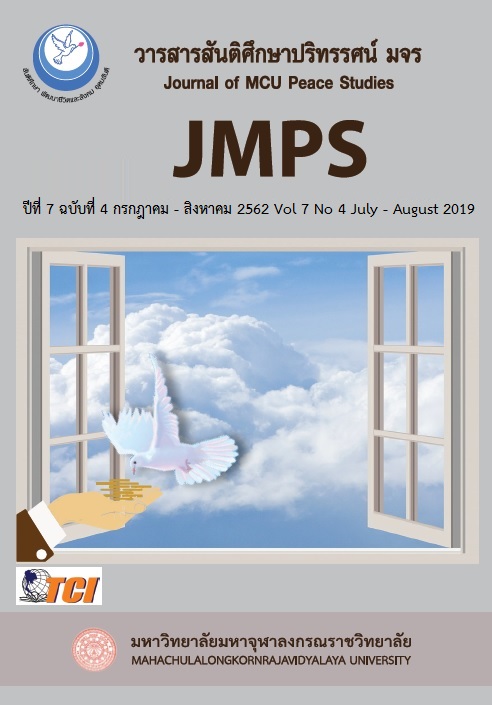รูปแบบการบริหารความเปลี่ยนแปลงของคณะสงฆ์ภาค 1
Main Article Content
บทคัดย่อ
The purpose of this research was to: to present the model of change management of the monastic sector 1 is a mixed method. 1) Quantitative research The 351 monks’ opinions were analyzed by means of statistical analysis, ie, mean and standard deviation, and 2) Qualitative research. The seminar was organized by a panel of 11 experts to develop this knowledge. There are 8 qualified speakers to review for their suitability. Analyze data by content analysis. The results of the study found that: The administrative situation of the monks of the monastic sector 1, found that the change management model of the monastic sector 1 is composed of four elements. Element 1: It is the development of the monk’s ability to create faith and create identity. And promote Buddhism to maintain morality, leading society to peace in the era of change. Element 2: The purpose is to develop a monastic organization to keep up with the changing environment. Do not abuse the principles and discipline in accordance with the law and the law. Element 3: 1) DEMMING (PDCA, Plan-Do-Check- Act). 2) The administration of the five disciplines is the planning of personnel organization, the supervision of the administration, 3) The management of the monks’ six branches, namely, the administration of religious education, the propagation of public works. Education 4) Change management is 4 aspects of structural change. Change people Organizational change Changes in technology. 5) The principle that promotes change management is Papanikadham 3, namely, shrewd, capable of administering business, having good credit rating.
Article Details
ทัศนะและความคิดเห็นที่ปรากฏในบทความในวารสาร ถือเป็นความรับผิดชอบของผู้เขียนบทความนั้น และไม่ถือเป็นทัศนะและความรับผิดชอบของกองบรรณาธิการ ยินยอมว่าบทความเป็นลิขสิทธิ์ของวารสาร
References
Buddhist Studies Division. (2010). National Office of Buddhism. Strategic Plan and Action Plan Education Development Buddhist Scripture School Ordinary Department of General Education B.E 2010-2019. Bangkok: Buddhist Studies Division.
Pinyonatthagarn, D. (2018). Mind and Enlightenment in Buddhism. Journal of MCU Buddhapanya Review, 3 (1), 31-44.
Krejcie, R. V. & Morgan, D. W. (1970). Determining Sample Size for Research Activities. Educational and Psychological Measurement, 30 (3), 607 - 610.
Mahachulalongkornrajavidyalaya University. (1996). Thai Tripitaka. Bangkok: MCU Press.
National Office of Buddhism. (2010). Strategic Plan and Action Plan Education Development Phrapariyattidham Schools of General Education (2010-2019). Bangkok: Buddhism Studies Division.
Nyani, Y. (2018). Buddhist Cardinal Principles for Peace and Harmony. Journal of MCU Buddhapanya Review, 3 (1), 19-29.
Phra Brahmagunabhorn (P.A. Payutto). (2015). Dictionary of Buddhism. (15th ed.). Bangkok: Phlithamma.
Phrakhrusophonthammapradit (Weerapat Junseinak. (2018). The Model of Educational Administration Based On Buddhist Method Department of General Education Phrapariyattidham Schools Nakhon Si Thammarat. Journal of MCU Peace Studies, 6 (4), 1372-1388.
Phrakrunonthakitkosol (Sirichai Kokrathok). (2019). The Development of Change Management Model Toward Excellence of The Buddhist Institutions. Journal of MCU Nakhondhat, 6 (1), 55-69.
Phramaha Sanya khantidhammo Treesawat. (2018). A Model of Thai Sangha Administration in the Future. Journal of MCU Peace Studies, 6 (1), 711-728.
Santikaro, B. (2014). The Development of Sangha Administration Model in 15th Region Sangha Administration. Dissertation Doctor of Philosophy (Buddhist Management). Graduate School. Mahachulalongkornrajavidyalaya University.

